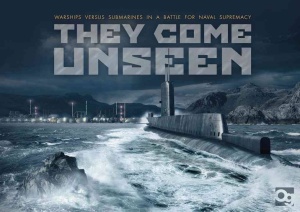 Commander Andy Benford was the living and breathing embodiment of Tom Clancy novels while many of us were still cutting our war gaming teeth on the likes of Risk, Stratego and Axis & Allies. (Okay, maybe also Panzer Blitz if you weren’t a total wimp.) Benford saw service aboard diesel-electric submarines, a nuclear-powered hunter-killer submarine and a nuclear-powered Polaris ballistic missile submarine, all during the Cold War. He retired from service in 1993.
Commander Andy Benford was the living and breathing embodiment of Tom Clancy novels while many of us were still cutting our war gaming teeth on the likes of Risk, Stratego and Axis & Allies. (Okay, maybe also Panzer Blitz if you weren’t a total wimp.) Benford saw service aboard diesel-electric submarines, a nuclear-powered hunter-killer submarine and a nuclear-powered Polaris ballistic missile submarine, all during the Cold War. He retired from service in 1993.
He also designed a game, They Come Unseen by Osprey Games.
Who better than a retired Cold War submariner to design a game that simulates the cat and mouse interactions between Soviet destroyers and NATO submarines in the stormy, icy waters of the Barents Sea? They Come Unseen does just that with palpably tense and exciting game play. That is when you’re not trying to clarify a rule in the 10-page FAQ.
The Subs
 As the NATO player, you’re controlling two diesel-electric hunter-killer submarines that are tasked with taking out four randomly assigned targets, Russian-controlled Ice Stations. The NATO player sits behind a screen that obscures a smaller version of the board in order to hide his movements while controlling and tracking the depth of his submarines (surface, 200ft., 400ft. or 600ft.) and keeping careful watch of his battery charge.
As the NATO player, you’re controlling two diesel-electric hunter-killer submarines that are tasked with taking out four randomly assigned targets, Russian-controlled Ice Stations. The NATO player sits behind a screen that obscures a smaller version of the board in order to hide his movements while controlling and tracking the depth of his submarines (surface, 200ft., 400ft. or 600ft.) and keeping careful watch of his battery charge.
The battery charge is a submarine’s “fuel,” and when it runs low, it’s time to “snort,” which is the term for describing the laughter induced by photos of a shirtless Vladimir Putin riding a horse. Or it means surfacing to charge the batteries. Naturally, this temporarily exposes the player to the Russians, who typically fire up the sonar and make a beeline to the vicinity as soon as possible.
The Destroyers
As the Russians, you’re controlling two destroyers tasked with protecting six Ice Stations by conducting sonar searches to locate and destroy the submarines. While moving around the grid on the game board, square by square, the Russian player is also coordinating a small fleet of logistics ships to keep vital stores of fuel and weaponry safe from attack.
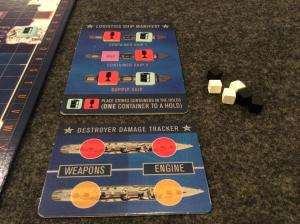 The Logistics Fleet
The Logistics Fleet
You see there’s more to this game than just searching for the enemy. The Russian destroyers don’t function on propaganda alone. They consume fuel as they move, and they consume salvos as they drop their depth charges, should they ever be so lucky.
These consumables (like the battery charge and the current depth of the NATO subs) are tracked on an impressive cardboard display, complete with cardboard needles that don’t flop around. In other words, you can drop, bump, stomp or throw these displays in anger, and your latest record will remain locked in place.
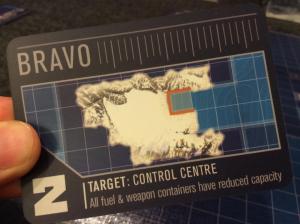 When it’s time to fuel up or replace salvos, destroyers can visit an Ice-Station or rendezvous with the supply ship. To simulate the transfer and movement of these resources, each container ship and the supply ship can carry up to two tokens of fuel and/or weapons, and Ice Stations can store any number of them.
When it’s time to fuel up or replace salvos, destroyers can visit an Ice-Station or rendezvous with the supply ship. To simulate the transfer and movement of these resources, each container ship and the supply ship can carry up to two tokens of fuel and/or weapons, and Ice Stations can store any number of them.
These resources begin the game stacked up at Ice Station Echo, and the Russians spend a good part of their turn shuttling fuel and weapons tokens between the remaining stations and holding them on board their logistics ships.
This logistics mini game provides a couple of challenges:
- Trying to maintain the proximity of these resources to the destroyers for ease of resupply, and
- Sufficiently spreading out the resources to mitigate their elimination if and when a NATO player destroys an Ice Station.
Destroy an Ice Station and all fuel and weapons tokens stored at the location are removed from the game.
Sub Hunting
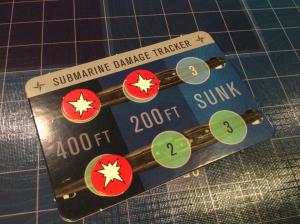 Sonar searches and the movement of the subs at different depths really serve as the bread and butter of They Come Unseen. This is by far the most thematically tense aspect of the game. If you’ve showed up to play a Cold War themed submarine game, you’ve come to the right place. The tension is baked into the chase.
Sonar searches and the movement of the subs at different depths really serve as the bread and butter of They Come Unseen. This is by far the most thematically tense aspect of the game. If you’ve showed up to play a Cold War themed submarine game, you’ve come to the right place. The tension is baked into the chase.
The NATO player has the constant worry of being detected by sonar; the Russian player worries that the submarines have slipped through their dragnet.
The main game board is color-coded and marked to indicate depth throughout, so the NATO player is not only having to watch the destroyers’ movements, but figure out how deep to run and for how long. There is the constant pressure of a dwindling battery supply, the impending necessity to recharge (surface), the desire to remain hidden for as long as possible, and the struggle to continue pressing toward the ultimate destruction of four Ice Stations.
Sonar Search & Salvos
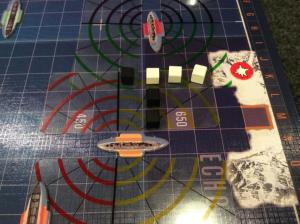
I took these photos during our first game, during which we used sonar INCORRECTLY. I was hamstringing myself as the Russian player. The correct way to place sonar templates is to represent all four colors for EACH destroyer. In other words, the Russian player will at least know what quadrant a sub is in should he make contact.
The actual sonar searching is an exciting part of the game. The player moving the destroyer pauses and places a sonar template on the starboard and ports sides of his ship. These two templates feature four different colors, one for each quadrant of the sonar search. You might say, “Contact Green” when and if the Russians lay the template in an area that includes the square in which you’re hiding.
Assuming contact was made, the Russian player will use one of his “Salvos” of depth charges to damage or kill your sub. In attempting to find it, he will place three white cubes and three black cubes in six different squares of the template and within the color where contact was made. He’ll also have to announce a depth for the white cubes and a depth for the black cubes. The Russian player might say, “white cubes at 200ft and black cubes at 600ft.”
The submarine commander will answer in turn with a “hit” a “miss” or a “near miss,” meaning the depth was off but the targeted square was correct. The first hit on a sub results in a maximum operating depth of 400ft. (no more deep dives), the second hit reduces the max depth to 200ft. and a third hit takes it out. A near miss results in a partial hit, two of which equal a regular hit.
While you may be tempted to fire off a torpedo salvo at the Russian destroyers, thematically the NATO player is restricted from attacking the Russian destroyers directly. You don’t want an international incident on your hands. The submarines can only sneak up to their Ice Station targets to drop off a passel of saboteurs. There’s one other aggressive option for enterprising sub commanders, and that is seeding the shallow waters with a strip of mines. You get to do this twice, and it’s a good deal of fun figuring out where you might damage a destroyer or blow up a logistics vessel.
The Forecast
As the rulebook aptly suggests, you should consider playing the game a few times before adding weather to the mix. When you finally do, the strategies you’ll use will be far more complex. With four types of weather in three zones across the board, you’ll have to adjust your movement strategies to compensate.
Rough Seas, for example, reduces ship movement by 5 squares, prevents transfers of fuel and weapons between container and supply ships, and interferes with sonar at 400ft. and 600ft. Guess which depth your submarines will run at in rough seas?
Thick and Thin
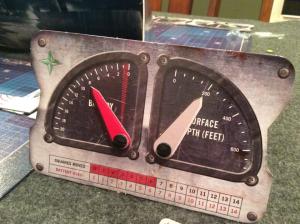 They Come Unseen is tremendous fun to play, but there are number of little things that sometimes overshadow an otherwise exceptional design.
They Come Unseen is tremendous fun to play, but there are number of little things that sometimes overshadow an otherwise exceptional design.
- While the submarine and destroyer control panels are of amazingly high quality, the cardboard tokens and chits in the game are some of the flimsiest I have ever seen. The weapons tokens, the fuel tokens, the strip of mines, the damage tracker cards, the damage and near miss tokens, are all so thin that one could accidentally fold a marker in half if it was picked up and pinched too forcefully. The thin counters also make it more difficult to retrieve them from the board.
- The destroyers and logistics ships are printed identically on both sides of the counter, so why not put an “x” on one side so that the ships can be flipped after they move? When things got crowded on the board, we sometimes lost track of which ships had already moved, and this simple printing adjustment would help.
- Similarly, there should be a token or cube or something to mark where your ship originated. There are a lot of little squares on the board, and backtracking is sometimes impossible if you don’t mark your spot at the start of movement. (This can be especially important with the mine detonation rules which require the NATO player to carefully watch the destroyer movements, a certain number of which can trigger them.) Like a lot of these gripes, this doesn’t break the game, but I generally don’t want to have to devise “fixes” for these things on my own. Just use a spare token to mark your spot, and you will be good to go.
- The mini board that’s hiding behind the screen comes with its own set of smaller sonar templates. The problem is that these templates are not printed with the grid on them, and they aren’t plastic and transparent like the ones used for the destroyer. The destroyer sonar templates are awesome. Why not make the smaller ones awesome, too?
- Finally, the print job on the destroyer and logistic ship markers are off-center. The printer should have caught this, and Osprey should have caught it, too. Either that or I ended up with a rare misprinted batch. The ships are designed with a square-shaped middle so as to indicate the square in which you’re located. With the misprint, I declare it’s the end of the world.
A Great Rule Book Comes Unseen
The final beef is worthy of it’s own sub-head. There were frankly a lot of questions that turned up while playing the game, and the rulebook provided little solace. I won’t give you a laundry list of all the things that were not clear in the rule book, but don’t take my word for it. Just visit the game’s Boardgamegeek page and download the 10-page FAQ, especially if you buy the game. Do yourself a favor, and read the FAQ before your first run through. It is a terrific, albeit necessary, resource.
I commend the designer for taking the time to answer so many questions in this FAQ.
Overall, They Come Unseen has great fundamentals, but needs more polish. Here’s to hoping Osprey Games one day publishes a second edition with better rules, more gameplay examples and perhaps some upgraded components. (Did someone say, miniatures?)
There is an amazing, fun and tense game hiding inside They Come Unseen, but the lackluster rule book may leave you frustrated if you don’t make the FAQ required reading.
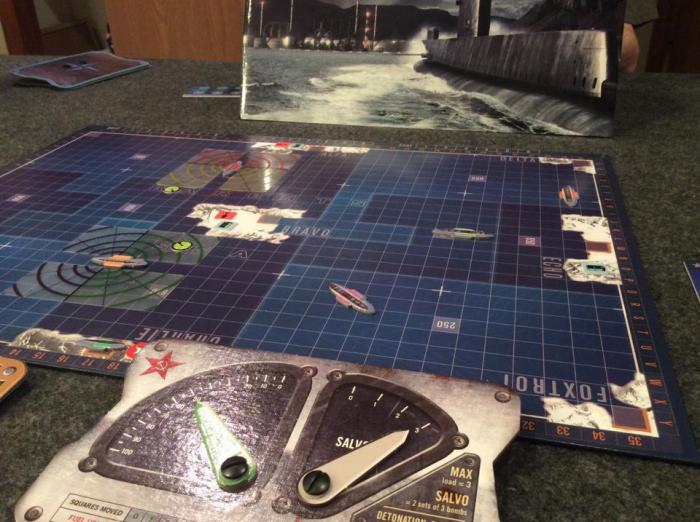
Leave a comment